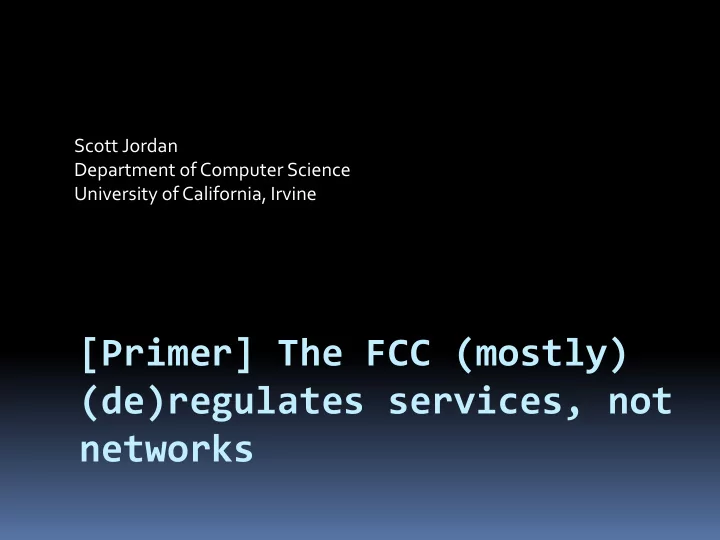

Scott Jordan Department of Computer Science University of California, Irvine [Primer] The FCC (mostly) (de)regulates services, not networks
Network vs. service Service: Class of service Service Network: Equipment Class of network Network Regulation: Regulation of service Regulation of network 2
Class of service Telecommunications: the transmission … of information of the user's choosing, without change in the form or content … Telecommunication service: the offering of telecommunications for a fee directly to the public … regardless of the facilities used What constitutes a change in the form or content? 3
Service Broadband Internet access service: a mass-market retail service that provides the capability to transmit data to and receive data from all or substantially all Internet endpoints … by wire or radio What is the geographical scope of the service? Last-mile? Interconnection? If the service includes both telecommunications and an information service component, are they separable? 4
Equipment Telecommunications equipment: equipment … used by a carrier to provide telecommunications services … Note connection between equipment and service, but not exclusive use 5
Class of network Telecommunications network: the telecommunications facilities and equipment including the software, features, functions, and capabilities that are provided by means of such facilities and equipment used in the provision of a telecommunications service Note connection between network and service, but not exclusive use 6
Network Public switched network: any common carrier switched network … that uses the North American Numbering Plan or public IP addresses (?) in connection with the provision of switched services Note connection between public switched network and service, but not exclusive use Note problem caused by pairing of network with addressing scheme 7
Regulation of service The FCC (mostly) (de)regulates services, not networks Usually the service determines the type of regulation: Title II: telecommunication services Section 332: mobile services commercial mobile service vs. private mobile service Title VI: multichannel video programming, cable service Section 202: Discrimination It shall be unlawful for any common carrier [i.e. provider of telecommunications service] to make any unjust or unreasonable discrimination in charges, practices, classifications, regulations, facilities, or services … 8
Regulation of network But the FCC (sometimes) (de)regulates networks Interconnection Each telecommunications carrier has the duty to interconnect directly or indirectly with the facilities and equipment of other telecommunications carriers … Unbundling Each incumbent local exchange carrier has the duty to provide … nondiscriminatory access to network elements on a unbundled basis … … in a manner that allows requesting carriers to combine such elements in order to provide telecommunications service 9
The big regulatory challenge: convergence Fixed telephone service Mobile voice service Title II Title II / III Internet Everything-Over-IP BIAS Title II / III (?) Cable tv service Title I (?) Title VI 10
Challenge: Where does the Title II service begin? Netflix backend Level3 Peering Peering IXP IXP CDN CDN Comcast 11
Challenge: What services fall under which Title? WiFi WiFi STB capacity for MVPD services capacity for BIAS OTT video Cable video Live / On- (Netflix, Hulu) over IP Recorded Demand MVPD partitions capacity for cable services between live and on-demand video app website MVPD may claim cable video over IP does not use BIAS capacity, and is thus not counted against data cap 12
Recommend
More recommend